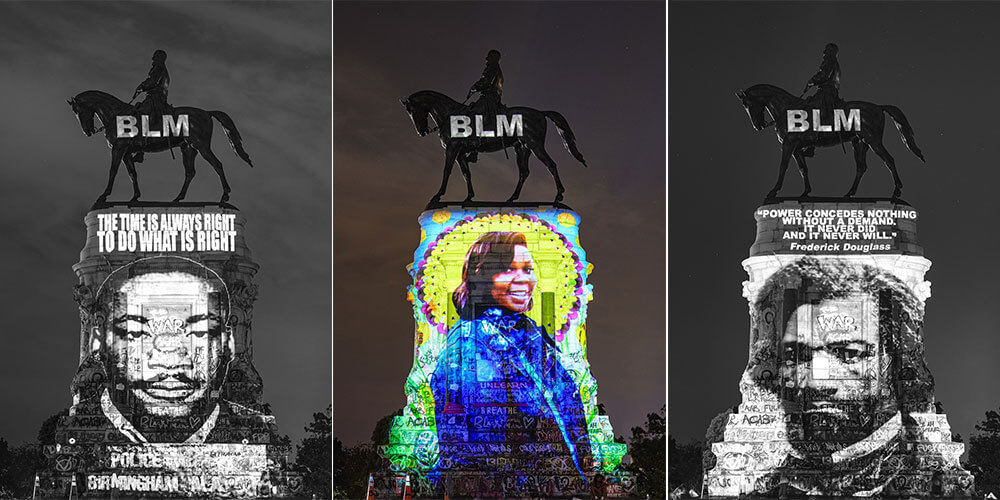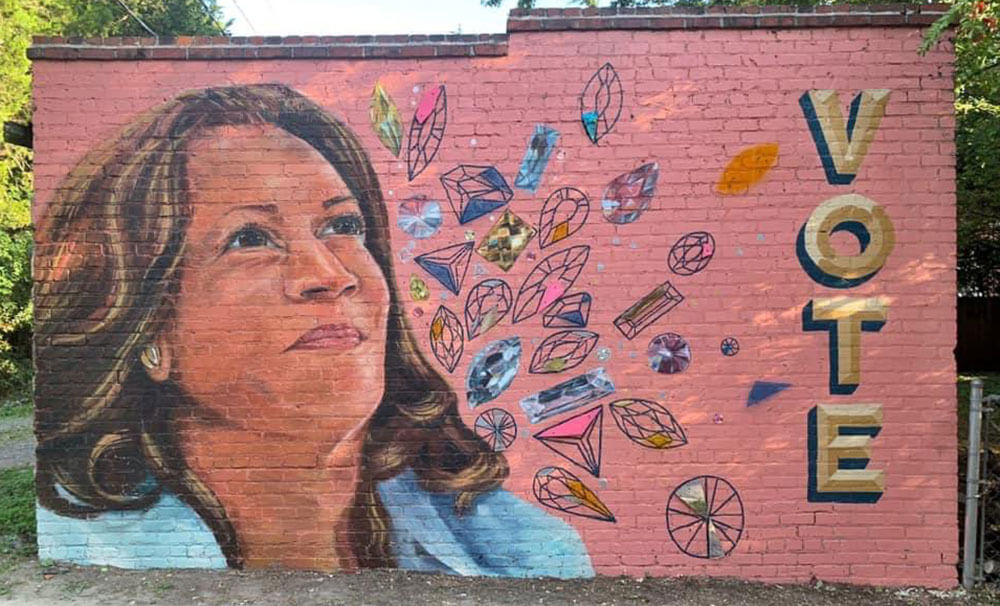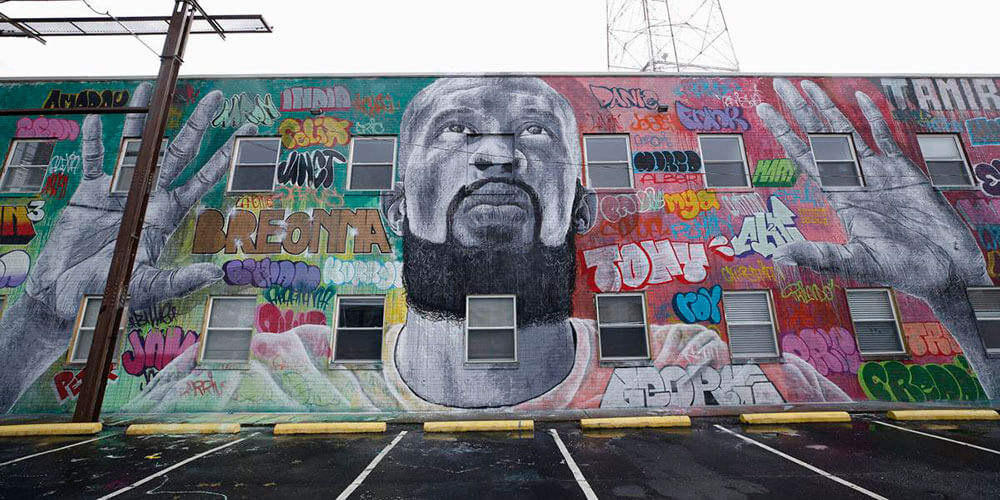
Light projection artist Dustin Klein reimagines the Robert E. Lee Monument in Richmond, Virginia, as a symbol of the Black Lives Matter movement with projected images of Martin Luther King Jr., Breonna Taylor, and Frederick Douglass.
How does a U.S. city with deep roots in slavery reconcile with its painful past? Richmond, Virginia — which was at the center of the domestic slave trade in North America — has chosen not to gloss over that past but invite exploration and provide opportunities for deeper understanding of the history of race in America.
One in four African Americans can find their origins in Richmond, home to the “Harlem of the South,” and a gateway to Black culture and the Black story that shaped the United States. Richmond celebrates its strong connection to Black history in the United States year-round and highlighted virtual and in-person opportunities to learn more during Black History Month, either safely in the destination or virtually from home. Here are some of the ways, provided by Visit Richmond.
Public murals, walls, and reclaimed spaces have grown as an important form of expression to address the current national conversation of racial reckoning and social justice. From institutional art in museums about the city’s history to grassroots art initiatives as well as overall protest art sparked from the recent protests over police brutality, visitors to Richmond can walk the streets of the vibrant destination to experience art that reflects the city’s rich culture, history, and diversity. Highlights for travelers to check out include the following:
- Mending Walls, a grassroots, collaborative public mural art project from local artist Hamilton Glass which brings artists of diverse cultures and backgrounds together.
- Protest art created by Dustin Klein (top of page) uses light projections of historical and current Black figures to recast the Robert E. Lee Monument at Marcus-David Peters Circle as a symbol of the Black Lives Matter movement. (For its “2020 Year in Photos” issue, National Geographic used an image of the light projection as the cover photo.)
- Kehinde Wiley’s Rumors of War at the Virginia Museum of Fine Arts, inspired by Confederate monuments, that depicts a young African American, dressed in urban streetwear, riding a horse.
- A mural depicting Vice President Kamala Harris from artists Michael-Birch Pierce and Nico Cathcart.

A mural of Vice President Kamala Harris Richmond’s Northside is called “Kamala: I’m speaking,” referencing what then candidate Harris told then-Vice President Mike Pence after he interrupted her during a debate.
Richmond also offers:
- The Black History Museum & Cultural Center of Virginia celebrates the rich culture and moving histories of African American people in Virginia and their contributions to the United States. The museum features permanent galleries exploring Emancipation, Reconstruction, Jim Crow, Desegregation, Massive Resistance, and the Civil Rights Movement.
- Maggie Walker Memorial Plaza honors the life and legacy of civil rights activist Maggie L. Walker with a 10-foot bronze statue designed by sculptor Toby Walker. The African American community leader devoted her life to defeating racism, sexism, and economic oppression. Walker chartered a bank, a newspaper, and a store 17 years before American women had the right to vote, and fostered black entrepreneurialism when Jim Crow laws threatened African American progress.
- Richmond’s American Civil War Museum is the first museum of its kind to explore the war through Union, Confederate, and African American perspectives. The 29,000-square-foot institution aims to provide a wider range of Civil War history while offering new and innovative ways to display items.
- Visitors can walk the self-guided Richmond Slave Trail, which includes 17 markers along the path that display somber and illuminating information on the history of slavery in Richmond.

“Say Their Names,” by artists Silly Genius and Nils Westergard, is part of the Mending Walls project in Richmond.
In addition, check out the schedule of virtual events celebrating Black History Month in Richmond:
The Other Madisons: The Lost History of a President’s Black Family
Join the Library of Virginia on Feb. 18 for a virtual genealogical book lecture by retired physician and geneticist Bettye Kearse, author of The Other Madisons: The Lost History of a President’s Black Family. Kearse—a descendant of an enslaved cook and, according to oral tradition, President James Madison—shares her family story and explores the issues of legacy, race, and the powerful consequences of telling the whole truth.
Wilton Uncovered
In 1998, William & Mary archaeologists uncovered the material record of the lives of nearly a century of enslaved families. This excavation recovered not only the most important available tool for understanding daily life at Wilton House, the centerpiece of a 2,000-acre tobacco plantation, but the largest collection of objects associated with Wilton’s original location in existence. “Wilton Uncovered: Archaeology Illuminates an Enslaved Community,” displays this collection for the first time. Join to follow the development of “Wilton Uncovered,” and its art in a special Zoom presentation on Feb. 18.
Black History Month at the Virginia Museum of Fine Arts
Explore the Virginia Museum of Fine Arts’ growing collection of African American art and take part in virtual experiences that celebrate African American artists, the stories they tell, and the depth and breadth of the museum’s collection. In four weekly installments that began Feb. 4, African American Read-In, this year in a virtual format, will pair works of art with readings by notable figures from the greater Richmond community. Visit the Virginia Museum of Fine Arts website for the complete Black History Month schedule.
Richmond Virginia Black Lives Matter Art Show
Now in its fourth year, BLM RVA ART 2021 includes 130-plus works from 80-plus artists. The mission of the show is to gather the community together to combat institutional racism, to champion racial justice, to promote spaces for the Black imagination and to celebrate Black joy. The artwork is displayed in six online galleries: Injustice in America, The Black Pastoral, Inspiration and Aspiration, Identity, In Memoriam, and Black Lives Matter – Uncategorized. An Emerging Voices category highlights artists under the age of 18. (Online through 2021.)
Hidden in Plain Site
Hidden in Plain Site is a new virtual tour that shines light on the Black experience in America as exhibited through distinct, but easy-to-overlook sites around Richmond. The experience includes 11 stories told across 10 sites. Hidden in Plain Site is a virtual experience. It’s free and available on a desktop, mobile, or through a VR headset.
Black Is _____ 365
Because Black history cannot be condensed into a single month, ART 180 has unveiled an installation in the windows of its Atlas youth art center and gallery stating “Black Is _____ 365.” The display is the organization’s first action in their “Black Is _____ 365” partnership with creative agency Dream For Purpose. The year-long project will consist of one-time and ongoing art projects that seek to empower the young Black and brown people in Richmond to imagine themselves as they desire, free of limitations. The fillable blank invites anyone to contribute. (Online through 2021.)
